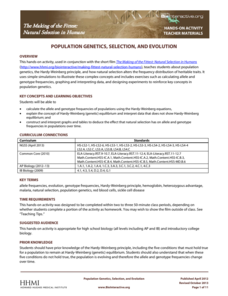Curated OER
Making Blood!
students research blood's components, and use their math skills to recreate a model of whole blood using commonly found food items.
Howard Hughes Medical Institute
Population Genetics, Selection, and Evolution
The Hardy-Weinberg principle states that alleles and genotypes remain constant in the absence of evolutionary influences. Scholars complete a simple hands-on activity applying the Hardy-Weinberg principle to sample data. They observe how...
Curated OER
Blood Types
In this algebra learning exercise, students examine the 4 different blood types, and make a graph deciding which blood types are compatible with each other when it comes to donors. There are 9 questions with an answer key.
Curated OER
Biology: Understanding Cellular Organelles
Students distinguish the differences between Prokaryotic and Eukaryotic cells. Using microscopes, they examine a variety of plant and animal cells. Working in groups, they draw and label plant and animal cells and show the mathematical...
IBM
The Human Body
Every moment, the systems in your body are working together to keep you breathing, standing, and thinking. Elementary schoolers explore the human body and its systems with an impressive, 15-page lesson plan that should leave your...
Curated OER
Percents and Money
In this algebra worksheet, students rewrite word problems using algebraic symbols. They solve for the amount of population or money over a period of time. There are 10 questions with an answer key.
Curated OER
Pea Brain! Explorations in Estimation
Students estimate how many peas fit in a container. In this science instructional activity, students calculate the weight of a pea and record it. They use this data to calculate how many peas fit in a human brain.
Other popular searches
- Red Blood Cells Slide
- Red Blood Cells Micro
- Red Blood Cells Microscopy
- Counting Red Blood Cells
- Muscle Red Blood Cells
- Frogs Red Blood Cells






